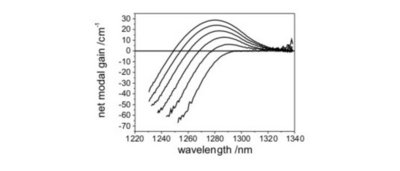GAIN SPECTROSCOPY OF SEMICONDUCTORS
Optical gain due to inversion in an active medium is the basic requirement for the operation of usual semiconductor lasers. Therefore a detailed knowledge of the gain of a active semiconductor medium is indispensable for developing semiconductor lasers. Moreover, insights into the gain mechanism allow further improvements of laser devices which cannot be obtained by usual investigation of the photoluminescence alone. On the one hand a low threshold current requires a large gain, on the other hand an as broad as possible gain spectra is important for a large temperature operation range, especially for vertical-cavity surface-emitting lasers (VCSELs). Finally a high differential gain is crucial for fast laser dynamics. Depending on the application, the gain of the active material has to be optimised for optimum performance.
We are using multiple techniques to investigate the optical gain, as the common method of Hakki and Paoli, a self developed transmission method or the all optical stripe length method. This enables us to investigate different type of samples from fully developed and processed laser devices to unprocessed photoluminescence samples from early states of material development. We are able to obtain temperature und polarization dependent gain spectra in pulsed and continuous wave operation in order to get detailed information about the relevant gain mechanism and the underlying transition and energy states.
Moreover experimental gain results measured in our group, can be compared with calculation based on a microscopic many-body theory, obtained by the groups of S.W. Koch, University of Marburg and J. Moloney, University of Arizona, Tucson, USA. Such comparisons lead to further insights into the gain mechanism and allow direct development and optimisation of the laser material. Our work is primary focused on the optical gain and the gain mechanism of new material systems as the metastable GaInNAs system or quantum dot systems.
Reference:
- M.R. Hofmann et al., Emission dynamics and optical gain of 1.3µm (GaIn)(NAs)?GaAs lasers, IEEE J. Quantum Electron. 38, 213 (2002).
- J Hader et al., Quantitative prediction of semiconductor laser characteristics based on low intensity photo luminescence measurements, IEEE Photon. Technol. 14, 762 (2002).
- N.C. Gerhardt et al., Linewidth enhancement factor and optical gain in (GaIn)(NAs)?GaAs lasers, Appl. Phys. Lett. 84, 1 (2004).
- N.C. Gerhardt et al., Experimental analysis of the optical gain and linewidth enhancement factor of GaInNAs/GaAs lasers, J. Phys.: Condens. Matter 16, 1 (2004).
Colleagues:


